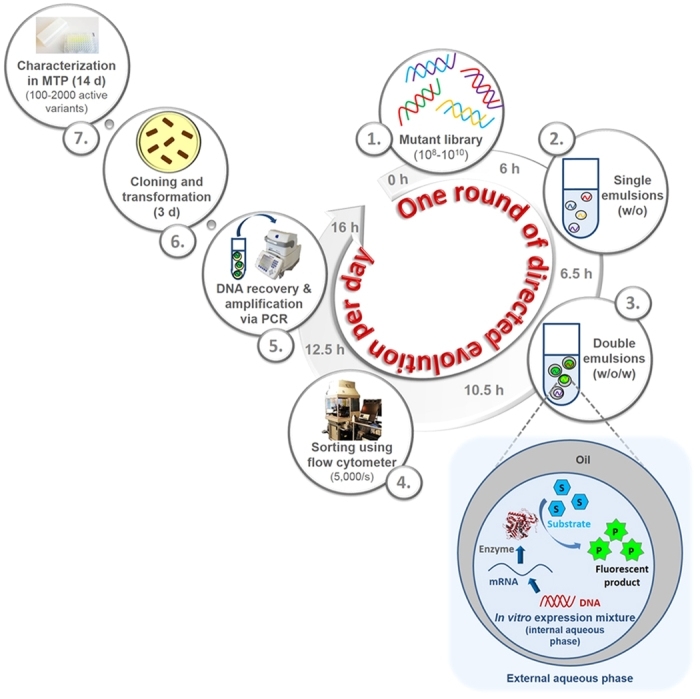FCB [Fluorescein di-beta-D-cellobioside]
This non-fluorescent fluorescein substrate generates the bright fluorescein product that has Ex/Em = 492/514 nm, and can be easily detected with a FITC filter set. In general, fluorescein substrates are much more sensitive than coumarin or nitrophenol-based substrates. This fluorescein substrate is used for monitoring cellulase activities. Cellulases are a family of enzymes that include β-glucosidases, endoglucanases and exoglucanases. These enzymes cleave the β-1,4-D-glycosidic bonds that link the glucose units comprising cellulose. In addition to being produced by plants, cellulase activity is found in many fungi and bacteria, including some plant pathogens. Most animal cells are not known to produce cellulase, in which the cellulolytic activity is often carried out by symbionts. The study of cellulase activity has many applications in plant molecular biology, agriculture, and manufacturing. Cellulase is becoming important in the development of alternative fuel sources, as glucose obtained from cellulose hydrolysis is easily fermented into ethanol. Activity of most cellulases can be conveniently monitored using this sensitive fluorescein cellobioside. Upon cleavage, the fluorescent compound, fluorescein, is released and activity measurements are easily obtained in a microtiter plate based assay format.
Calculators
Common stock solution preparation
Table 1. Volume of DMSO needed to reconstitute specific mass of FCB [Fluorescein di-beta-D-cellobioside] to given concentration. Note that volume is only for preparing stock solution. Refer to sample experimental protocol for appropriate experimental/physiological buffers.
| 0.1 mg | 0.5 mg | 1 mg | 5 mg | 10 mg | |
| 1 mM | 101.95 µL | 509.752 µL | 1.02 mL | 5.098 mL | 10.195 mL |
| 5 mM | 20.39 µL | 101.95 µL | 203.901 µL | 1.02 mL | 2.039 mL |
| 10 mM | 10.195 µL | 50.975 µL | 101.95 µL | 509.752 µL | 1.02 mL |
Molarity calculator
Enter any two values (mass, volume, concentration) to calculate the third.
| Mass (Calculate) | Molecular weight | Volume (Calculate) | Concentration (Calculate) | Moles | ||||
| / | = | x | = |
Spectrum
Citations
View all 4 citations: Citation Explorer
Thermostable in vitro transcription-translation compatible with microfluidic droplets
Authors: Ribeiro, Ana LJL and P{\'e}rez-Arnaiz, Patricia and S{\'a}nchez-Costa, Mercedes and P{\'e}rez, Lara and Almendros, Marcos and van Vliet, Liisa and Gielen, Fabrice and Lim, Jesmine and Charnock, Simon and Hollfelder, Florian and others,
Journal: Microbial Cell Factories (2024): 1--14
Authors: Ribeiro, Ana LJL and P{\'e}rez-Arnaiz, Patricia and S{\'a}nchez-Costa, Mercedes and P{\'e}rez, Lara and Almendros, Marcos and van Vliet, Liisa and Gielen, Fabrice and Lim, Jesmine and Charnock, Simon and Hollfelder, Florian and others,
Journal: Microbial Cell Factories (2024): 1--14
Microfluidic Screening And Genomic Mutation Identification For Enhancing Cellulase Production in Pichia Pastoris
Authors: Yuan, Huiling and Zhou, Ying and Tu, Ran and Lin, Yuping and Guo, Yufeng and Zhang, Yuanyuan and Wang, Qinhong
Journal: (2021)
Authors: Yuan, Huiling and Zhou, Ying and Tu, Ran and Lin, Yuping and Guo, Yufeng and Zhang, Yuanyuan and Wang, Qinhong
Journal: (2021)
Droplet-based microfluidic platform for high-throughput screening of Streptomyces
Authors: Tu, Ran and Zhang, Yue and Hua, Erbing and Bai, Likuan and Huang, Huamei and Yun, Kaiyue and Wang, Meng
Journal: Communications biology (2021): 1--9
Authors: Tu, Ran and Zhang, Yue and Hua, Erbing and Bai, Likuan and Huang, Huamei and Yun, Kaiyue and Wang, Meng
Journal: Communications biology (2021): 1--9
In vitro flow cytometry-based screening platform for cellulase engineering
Authors: Körfer, Georgette and Pitzler, Christian and Vojcic, Ljubica and Martinez, Ronny and Schwaneberg, Ulrich
Journal: Scientific reports (2016)
Authors: Körfer, Georgette and Pitzler, Christian and Vojcic, Ljubica and Martinez, Ronny and Schwaneberg, Ulrich
Journal: Scientific reports (2016)
References
View all 25 references: Citation Explorer
Interaction of cellulase with cationic surfactants: using surfactant membrane selective electrodes and fluorescence spectroscopy
Authors: Rastegari AA, Bordbar AK, Taheri-Kafrani A.
Journal: Colloids Surf B Biointerfaces (2009): 132
Authors: Rastegari AA, Bordbar AK, Taheri-Kafrani A.
Journal: Colloids Surf B Biointerfaces (2009): 132
Immobilization of cellulose fibrils on solid substrates for cellulase-binding studies through quantitative fluorescence microscopy
Authors: Moran-Mirabal JM, Santhanam N, Corgie SC, Craighead HG, Walker LP.
Journal: Biotechnol Bioeng (2008): 1129
Authors: Moran-Mirabal JM, Santhanam N, Corgie SC, Craighead HG, Walker LP.
Journal: Biotechnol Bioeng (2008): 1129
Analysis of cellulase synthesis mechanism in Trichoderma reesei using red fluorescent protein
Authors: Liu G, Zhang Y, Li Y, Yu SW, Xing M.
Journal: Wei Sheng Wu Xue Bao (2007): 69
Authors: Liu G, Zhang Y, Li Y, Yu SW, Xing M.
Journal: Wei Sheng Wu Xue Bao (2007): 69
The linker region plays a key role in the adaptation to cold of the cellulase from an Antarctic bacterium
Authors: Sonan GK, Receveur-Brechot V, Duez C, Aghajari N, Czjzek M, Haser R, Gerday C.
Journal: Biochem J (2007): 293
Authors: Sonan GK, Receveur-Brechot V, Duez C, Aghajari N, Czjzek M, Haser R, Gerday C.
Journal: Biochem J (2007): 293
Use of an enhanced green fluorescence protein linked to a single chain fragment variable antibody to localize Bursaphelenchus xylophilus cellulase
Authors: Zhang Q, Bai G, Cheng J, Yu Y, Tian W, Yang W.
Journal: Biosci Biotechnol Biochem (2007): 1514
Authors: Zhang Q, Bai G, Cheng J, Yu Y, Tian W, Yang W.
Journal: Biosci Biotechnol Biochem (2007): 1514
Page updated on April 25, 2025




